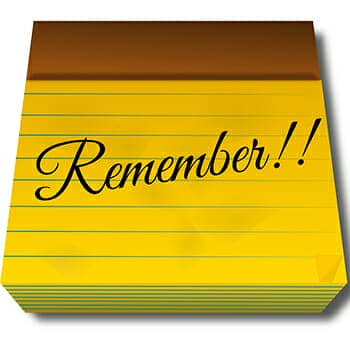 I receive a lot of questions about the Magnetic Memory Method and how to use it effectively. Unfortunately, the core of many of these questions reveal that a lot of people are trying to take shortcuts.
I receive a lot of questions about the Magnetic Memory Method and how to use it effectively. Unfortunately, the core of many of these questions reveal that a lot of people are trying to take shortcuts.
Although I can admire looking for faster paths to the goal, and the Magnetic Memory Memory is ultimately all about shortcuts…
Sometimes there are no shortcuts to the shortcut.
That’s why building your own mnemonic systems can sometimes feel like a huge step backwards as you develop fundamental skills.
Yet, once you’ve set yourself up, you will have a memorizing jetpack strapped to your brain with its GPS set to mastering any topic you want.
So, instead of providing shortcuts that lead you nowhere, here are some “tricks” that will help make sure you’re developing as a mnemonist in the most “Magnetic” manner possible.
1. Know Your Memory Palaces
It takes only a moment to walk through them. While you’re in there, use your imagination to amplify everything. The more bright and vivid your Memory Palaces are, the more magnetic they will be.
2. Know Your Objective
If you say to yourself that you’re going to memorize some words today, you’re not going to be nearly as effective as if you said “I’m going to memorize 10 words today.” That’s a concrete number, something the mind can wrap its cells around.
Better yet, you can say something like, “I’m going to memorize 10 words every day in July.”
When you set a specific objective like this, the likelihood of success goes way up. But if you have no objective, no plan that you’ve clearly defined, then surely the results will fail to follow.
Success sticks “magnetically” to well-defined goals, so be sure to make some and make them concrete. Write them in a journal for best results.
3. Choose Your Words in Advance
Pick a range of words that you’re going to work on in advance. Will they be words that start with “ac” or “de” or “zu”?
If you don’t want to practice the Magnetic Memory principle of alphabetization and word division, then at least spend some time thinking about the kinds of words you could gather together to advance your fluency.
If you don’t know what those words might be, record yourself talking. Meet with a friend and explain that you want to track the kinds of words you use during the day for your language learning project and then listen to yourself later.
Every word that you spoke in your mother tongue but didn’t know in your target language can become the basis for the next list of words you will Magnetically store in your Memory Palaces.
4. Memorize Recklessly, But with Relaxation
A lot of people worry about making mistakes, or that they will waste a Memory Palace they might want to use for important information.
Although it is possible to ruin Memory Palaces, I don’t think you can waste them.
In fact, it’s a waste not to work a little bit recklessly, both as a beginner and at the intermediate and expert levels.
What I mean here is that you should work fast. The only way to get faster with mnemonic imagery, after all, is to practice assigning it in your Memory Palaces quickly. Don’t fear making mistakes or having to struggle to reconstruct the information you’ve learned. You generally won’t have to.
Another reason to work speedily is because speed attracts memorization.
Let’s say you’re learning a language. If you sit with a dictionary and hum and haw over the associations you’re going to create, you lose traction and interest.
Rather, the mind likes to work fast in order to enjoy the processes of discovery. Moving as quickly as possible will also give you greater mental strength. You can also practice increasing your strength of mind by adding obstructions while memorizing, something I discuss with my friend and 2x USA Memory Champion John Graham.
But no matter how fast you go, make sure that you are always fully elaborating your associations by making them large, bright, vivid and truly zany.
Most important, move fast, but don’t get yourself into frenzy.
Always relax. Do the breathing and muscle exercises discussed my books and courses before you get started so that you are calm and receptive to the amazing associations your mind wants to bring to you.
5. Test Intelligently and Ruthlessly
Far too many people I talk to don’t test their memory work. They wait until a situation arises when they’ll need the words they learn and then struggle to find them.
The first reason people can’t find them has to do with points 1-4 above, particularly the point about relaxation. We relax while memorizing in order to condition ourselves to be relaxed during recall.
But without testing the associations you’ve placed into your Memory Palaces before using them in a real conversation, how do you know how well they’ve stuck?
The answer is:
You Don’t.
There are three ways of testing: in your mind, on paper or using a digital resource like an Excel file.
To test in your mind, you simply walk through your Memory Palace and decode the words you created associations for.
However, please watch out for this problem:
If you test with a list of words in front of you, you risk falling back on rote learning because you are essentially looking at your Excel file or journal far too often.
That’s why I don’t really recommend constantly looking at the same information without some kind of chunking strategy and elaborative rehearsal based around proper spaced repetition.
In case you haven’t seen it, here’s the video I made for you regarding the Excel file method of storage:
Far better is to walk through your mind and decode each word you’ve memorized and then write it down with a pencil or pen on paper.
Write down all the words you’ve recently memorized but haven’t put through a testing cycle yet, and then an hour later or so, open up your Excel file and compare the efforts you produced purely out of your mind with your written record.
You’ll be amazed by how well you do. But if you come across little issues, you’re going to be in a very good position to correct them by going into your Memory Palaces and amplifying/altering the images that aren’t doing their job for you. There are no mistakes, only opportunities to learn, so please use objective reasoning any time something seems to go awry.
For more testing tips, check out how memory athlete Johannes Mallow uses his digital journal.
I hope these points help those of you who are struggling. If you have any further questions, rest assured that I am Magnetized to my inbox and will get back to you as soon as I can.
Until next time, pop open that Excel file and tell someone what you’ve learned about memorization. Teaching a skill is one of the best ways to learn it and helping people improve their memory is one of the best ways we can make the world a better place. The more we remember, the more we can remember.
And remember: the more we learn, the more we can learn.
Related Posts
- How To Use Memory Techniques At The Grocery Store
Check out these quick tips for practicing memory techniques at the grocery store. You'll learn…




2 Responses
Why does each memory palace need to use a letter of the alphabet? (Thank you very much for the 5 tips.)
Thanks for this, Quiliro.
It’s not that Memory Palaces must be associated with letters of the alphabet. It’s just a convenient, pre-organized structure that sits in the brain and helps reduce cognitive overload if you wanted to create a personal system with multiple Memory Palaces. It’s highly recommended that people who want to use location-based mnemonics for large projects (such as learning a language) do this.
However, the implications of having an alphabetized Memory Palace network do wonders for other areas as well, such as the study of philosophy, history and many other areas.
Do give it a try and I’m confident you’ll be astonished by how powerful this approach is.
Thanks again for your comment and talk soon!